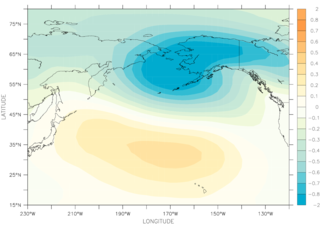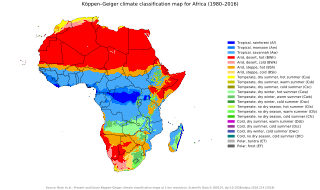Related Research Articles

Contrails or vapor trails are line-shaped clouds produced by aircraft engine exhaust or changes in air pressure, typically at aircraft cruising altitudes several miles above the Earth's surface. Contrails are composed primarily of water, in the form of ice crystals. The combination of water vapor in aircraft engine exhaust and the low ambient temperatures that exist at high altitudes allows the formation of the trails. Impurities in the engine exhaust from the fuel, including sulfur compounds provide some of the particles that can serve as nucleation sites for water droplet growth in the exhaust. If water droplets form, they might freeze to form ice particles that compose a contrail. Their formation can also be triggered by changes in air pressure in wingtip vortices or in the air over the entire wing surface. Contrails, and other clouds directly resulting from human activity, are collectively named homogenitus.

The climate of the Alps is the climate, or average weather conditions over a long period of time, of the exact middle Alpine region of Europe. As air rises from sea level to the upper regions of the atmosphere the temperature decreases. The effect of mountain topography on prevailing winds is to force warm air from the lower region into an upper zone where it expands in volume at the cost of a proportionate loss of heat, often accompanied by the precipitation of moisture in the form of snow, rain or hail.

A Foehn or Föhn, is a type of dry, relatively warm, downslope wind that occurs in the lee of a mountain range. It is a rain shadow wind that results from the subsequent adiabatic warming of air that has dropped most of its moisture on windward slopes. As a consequence of the different adiabatic lapse rates of moist and dry air, the air on the leeward slopes becomes warmer than equivalent elevations on the windward slopes.

Shida Kartli is a landlocked administrative region (Mkhare) in eastern Georgia. It comprises a central part of the historical-geographic province of Shida Kartli. With an area of 5,729 square kilometres (2,212 sq mi), Shida Kartli is the 8th largest Georgian region by land area. With 284,081 inhabitants, it is Georgia's seventh-most-populous region. Shida Kartli's capital and largest city, Gori, is the 5th largest city in Georgia.
David H. Douglass is an American physicist at the University of Rochester.

The Interdecadal Pacific oscillation (IPO) is an oceanographic/meteorological phenomenon similar to the Pacific decadal oscillation (PDO), but occurring in a wider area of the Pacific. While the PDO occurs in mid-latitudes of the Pacific Ocean in the northern hemisphere, the IPO stretches from the southern hemisphere into the northern hemisphere.
Land surface models (LSMs) use quantitative methods to simulate the exchange of water and energy fluxes at the Earth surface–atmosphere interface. They are key component of climate models. Over the past two decades, they have evolved from oversimplified schemes, which described the surface boundary conditions for general circulation models (GCMs), to complex models that can be used alone or as part of GCMs to investigate the biogeochemical, hydrological, and energy cycles at the earth's surface.
Košava is a cold, very squally southeastern wind found in parts of Eastern Europe and the Balkans. It starts in the Carpathian Mountains and follows the Danube northwest through the Iron Gate region where it gains a jet effect, then continues to Belgrade. It can spread as far north as Hungary and as far south as Niš and Sofia.
Mango showers is a colloquial term to describe the occurrence of pre-monsoon rainfall. Sometimes, these rains are referred to generically as ‘April rains’ or ‘Summer showers’. They are notable across much of South and Southeast Asia, including India, and Cambodia. In southern Asia, these rains greatly influence human activities because of the control the rains have on crops that are culturally significant like mangoes and coffee.
Dr. Patrick N. Keating was a theoretical physicist who contributed to several fields of solid-state physics, including semiconductors, semi-insulators and the basic properties of solid materials, and to other fields including optics, liquid crystals, acoustic holography, and signal processing. He was best known for the Keating Model of interatomic forces in tetrahedrally-coordinated solids.

The North Pacific Oscillation (NPO) is a teleconnection pattern first described by Walker and Bliss and characterized by a north–south seesaw in sea-level pressure over the North Pacific Ocean.
Rogers, using surface atmospheric temperature from St. Paul, Alaska, and Edmonton, identified two phases of the NPO, an Aleutian below (AB) phase that correspond to a deepened and eastward shifted Aleutian Low and an Aleutian above (AA) phase that is the opposite.

The International Comprehensive Ocean-Atmosphere Data Set (ICOADS) is a digital database of 261 million weather observations made by ships, weather ships, and weather buoys spanning the years 1662 to 2007. The database was initially constructed in 1985 and continues to be expanded upon and updated on a regular basis. From the original data, gridded datasets were created. ICOADS information has been useful in determining the reliability of ship and buoy wind measurements, helping to determine temperature trends in the sea surface temperature field, and updating the Atlantic hurricane database.

The climate of Africa is a range of climates such as the equatorial climate, the tropical wet and dry climate, the tropical monsoon climate, the semi-arid climate, the desert climate, the humid subtropical climate, and the subtropical highland climate. Temperate climates are rare across the continent except at very high elevations and along the fringes. In fact, the climate of Africa is more variable by rainfall amount than by temperatures, which are consistently high. African deserts are the sunniest and the driest parts of the continent, owing to the prevailing presence of the subtropical ridge with subsiding, hot, dry air masses. Africa holds many heat-related records: the continent has the hottest extended region year-round, the areas with the hottest summer climate, the highest sunshine duration, and more.
Homogenization in climate research means the removal of non-climatic changes. Next to changes in the climate itself, raw climate records also contain non-climatic jumps and changes, for example due to relocations or changes in instrumentation. The most used principle to remove these inhomogeneities is the relative homogenization approach in which a candidate station is compared to a reference time series based on one or more neighboring stations. The candidate and reference station(s) experience about the same climate, non-climatic changes that happen only in one station can thus be identified and removed.

The Goldberg Group is a sub-group of the Hohe Tauern mountain range within the Central Eastern Alps. It is located in Austria, in the states of Salzburg and Carinthia. Its highest peak is the Hocharn, 3,254 m (AA). Other well known summits are the Hoher Sonnblick, with its observatory at 3,106 m above sea level (AA), and the Schareck at 3,123 m above sea level (AA)

The Hoher Sonnblick is a glaciated mountain, 3,106 m (AA) high, on the main Alpine chain in the Goldberg Group on the border between the Austrian states of Carinthia and Salzburg. At its summit is the Sonnblick Observatory and the Alpine refuge hut of Zittelhaus.

In meteorology, a precipitationshed is the upwind ocean and land surface that contributes evaporation to a given, downwind location's precipitation. The concept has been described as an "atmospheric watershed". The concept itself rests on a broad foundation of scholarly work examining the evaporative sources of rainfall. Since its formal definition, the precipitationshed has become an element in water security studies, examinations of sustainability, and mentioned as a potentially useful tool for examining vulnerability of rainfall dependent ecosystems.

Michael Lehning is a German and Swiss environmental and atmospheric scientist. He is a professor of environmental engineering at EPFL, the head of EPFL's Laboratory of Cryospheric Sciences, and head of the group Snow Processes at the Swiss Federal Institute for Forest, Snow and Landscape Research (WSL).
Jacob Sebastian Haugaard Mernild is a Danish professor in climate change, glaciology and hydrology, who is the pro-vice-chancellor of the University of Southern Denmark. Mernild has been an Intergovernmental Panel on Climate Change (IPCC) author for the United Nations since 2010. Initially a contributing author on the IPCC Fifth Assessment Report, he was lead author on the IPCC Sixth Assessment Report.
Lisa Victoria Alexander is an international expert on heatwaves. She received the Dorothy Hill Medal for her research on climate extremes, the frequency and intensity of heatwaves, and has provided evidence that the frequency and intensity of heatwaves will be influenced by the quantity of anthropogenic greenhouse gas emissions, in particular carbon dioxide. She was a contributing author to the Intergovernmental Panel on Climate Change (IPCC) reports, including the fifth assessment report.
References
- 1 2 3 "40 Jahre Klimaforschung: Ingeborg Auer geht in den Ruhestand". Zentralanstalt für Meteorologie und Geodynamik. 25 November 2016.
- ↑ "CV Ingeborg Auer" (PDF). Zentralanstalt für Meteorologie und Geodynamik. 2009.
- ↑ "Klimazonen klettern stetig hinauf". science.orf.at. 14 October 2016.